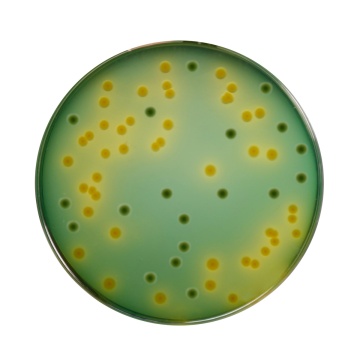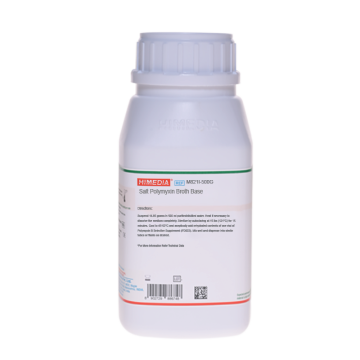 Your enquiry has been submitted
Your enquiry has been submitted
Tryptone Sucrose Tetrazolium Agar Base (TSTA)
Selective Isolation#CC293D
Intended Use
This medium with addition of Triphenyl Tetrazolium Chloride is recommended for isolation of Vibrio species.
Composition
| Ingredients | g/L |
|---|---|
| Tryptone | 15.000 |
| Soya peptone | 5.000 |
| Sodium chloride | 30.000 |
| Saccharose | 20.000 |
| Bile salts | 0.500 |
| Agar | 15.000 |
| Final pH (at 25°C) | 7.1±0.2 |
**Formula adjusted, standardized to suit performance parameters
Directions
Suspend 85.5 grams in 1000 ml purified/distilled water. Heat to boiling to dissolve the medium completely. Sterilize by autoclaving at 15 lbs pressure (121°C) for 15 minutes. Cool to 45-50°C and aseptically add 3 ml of 1% 2,3,5 Triphenyl Tetrazolium Chloride (TTC) (FD057). Mix well before pouring into sterile Petri plates.
Principle And Interpretation
The Vibrionaceae are straight or curved, gram-negative rods, motile by polar flagella. Many strains require 2-3% sodium chloride for growth and are primarily inhabitants of aquatic environments. Of the 3 Vibrio species recognized, 12 have been implicated in gastrointestinal and extra-intestinal infections in man; the most important of these is cholera. The species most frequently isolated from clinical specimens are strains of Vibrio cholerae, Vibrio parahaemolyticus, Vibrio vulnificus, Vibrio mimicus and Vibrio alginolyticus (1). Tryptone Sucrose Tetrazolium Agar is formulated in accordance with Kourany medium (2) and is approved by ISO Committee (3) for the isolation of Vibrio species, especially V.parahaemolyticus. Tryptone and soya peptone provide nitrogenous compounds and other essential growth nutrients. Saccharose (sucrose) is the energy source. High salt concentration imparts selectivity. Bile salts inhibit gram-positive organisms. TTC is reduced by V. parahaemolyticus to red formazan dyes, visualized as red colonies.
Type of specimen
Clinical samples - faeces samples; food samples
Specimen Collection and Handling:
Inoculate 25 grams of the test sample into 225ml of Salt Polymyxin Broth Base (M8211). Incubate at 35-37°C for 7 to 8 hours. After incubation, inoculate a loopful onto TCBS Agar (M189) & Tryptone Sucrose Tetrazolium Agar Base (M1217). Presumptive V. parahaemolyticus colonies are further confirmed by appropriate biochemical tests. After use, contaminated materials must be sterilized by autoclaving before discarding.
Warning and Precautions :
In Vitro diagnostic Use. For professional use only. Read the label before opening the container. Wear protective gloves/protective clothing/eye protection/ face protection. Follow good microbiological lab practices while handling specimens and culture. Standard precautions as per established guidelines should be followed while handling clinical specimens. Safety guidelines may be referred in individual safety data sheets.
Limitations :
- Individual organisms differ in their growth requirement and may show variable growth patterns on the medium.
- Presumptive V. parahaemolyticus colonies are further confirmed by appropriate biochemical tests.
Performance and Evaluation
Performance of the medium is expected when used as per the direction on the label within the expiry period when stored at recommended temperature.
Quality Control
Appearance Cream to yellow homogeneous free flowing powder
Gelling Firm, comparable with 1.5% Agar gel
Colour and Clarity of prepared medium Light yellow coloured clear to slightly opalescent gel forms in petriplates.
Reaction Reaction of 8.55% w/v aqueous solution at 25°C. pH: 7.1±0.2
pH 6.90-7.30
Cultural Response Cultural characteristics observed after an incubation at 35-37°C for 24-48 hours.
| Organism | Inoculum (CFU) | Growth | Recovery |
|---|---|---|---|
| Vibrio parahaemolyticus ATCC 17802 (00037*) | 50-100 | good-luxuriant | >=50% |
| Vibrio cholerae ATCC 15748 | 50-100 | good-luxuriant | >=50% |
Key: *Corresponding WDCM numbers.
Storage and Shelf Life
Store between 10-30°C in a tightly closed container and the prepared medium at 2-8°C. Use before expiry date on the label. On opening, product should be properly stored dry, after tightly capping the bottle in order to prevent lump formation due to the hygroscopic nature of the product. Improper storage of the product may lead to lump formation. Store in dry ventilated area protected from extremes of temperature and sources of ignition. Seal the container tightly after use. Product performance is best if used within stated expiry period.
Disposal
User must ensure safe disposal by autoclaving and/or incineration of used or unusable preparations of this product. Follow established laboratory procedures in disposing of infectious materials and material that comes into contact with clinical sample must be decontaminated and disposed of in accordance with current laboratory techniques (4,5).
Reference
- Collee J. G., Fraser A. G., Marmion B. P., Simmons A., (Eds.), Mackie and McCartney, Practical Medical Microbiology, 1996, 14th Edition, Churchill Livingstone
- Kourany M., 1983, Appl. Environ. Microbiol., 45: 310.
- International Organization for Standardization (ISO) 1990, Draft, ISO/DIS 8914.
- Isenberg, H.D. Clinical Microbiology Procedures Handbook 2nd Edition.
- Jorgensen, J.H., Pfaller, M.A., Carroll, K.C., Funke, G., Landry, M.L., Richter, S.S and Warnock., D.W. (2015) Manual of Clinical Microbiology, 11th Edition. Vol. 1.
| Product Name | Tryptone Sucrose Tetrazolium Agar Base (TSTA) |
|---|---|
| SKU | M1217 |
| Product Type | Regular |
| Physical Form | Powder |
| Origin | Animal |
| Packaging type | HDPE |
| References | 1. Collee J. G., Fraser A. G., Marmion B. P., Simmons A., (Eds.), Mackie and McCartney, Practical Medical Microbiology,1996, 14th Edition, Churchill Livingstone |
| Customized Product Available | No |









